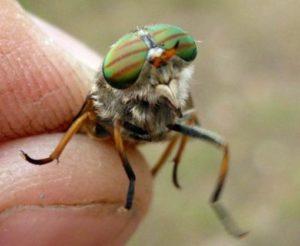Horseflies: photo and character of large bloodsucking insects
Summer smells of fresh berries, late nights and tanned knees. With the first rays of the sun, all living creatures wake up. And if some are beneficial, others are just annoying with their noise and importunity, there are those that can significantly spoil the rest. Such are horseflies.
Content
Horseflies: photo
Description of the insect
Name: Sweetbones
Latin:TabanidaeClass: Insects - Insecta
Squad: Diptera - Diptera
 | Habitats: | everywhere |
 | Dangerous for: | livestock, people |
 | Means of destruction: | traps, chemicals |
Horseflies are a large family of Diptera insects. They are ubiquitous and are tied to landscape and climatic conditions. They are found everywhere except Antarctica, Iceland and the islands of Hawaii.
Those who lived in the village and kept a household are very familiar with these large flies. Horseflies live with cows and horses. Females feed on the blood of ungulates in addition to nectar.
Horseflies carry a number of viruses, bacteria, helminths and protozoa that are a source of disease for humans and livestock.
Life cycle
An insect goes through several life cycle stages. These are eggs, larvae, pupae and adults.
Their size can vary from 1,3 mm to 3 mm. Their color depends on the conditions in which they develop. The dark ones are more in the northern regions to absorb the light. Depending on the type, they can be in one or more layers, in the form of a pyramid, fan or drop.
The shape can be fusiform or pear-shaped. They can be white, dark brown, brown or dark green. The length can vary depending on the species, from 1 to 5 cm.
They are brown, with legs, eyes, and wing buds. The length varies depending on 9 to 35 mm. They can grow in water or soil. They eat a lot, even prone to cannibalism.
adult, imago
Imago very quickly live their lives. Males live no more than 7 days, and in captivity they can last up to 3 weeks. Females live a little longer, but not more than a month.
| Head | Most species have large eyes, but there are those that are reduced. There are antennae and a piercing-cutting mouth apparatus. |
| Chest | The department is divided into 3 segments. Breast and two barrels, they are covered with hairs. |
| Wings | Well developed, one pair. |
| Legs | Three pairs of legs, on the back a pair of strong spurs. |
| Abdomen | Wide, slightly flattened. At the end of the copulatory apparatus. |
Adult lifestyle
Interestingly, the fastest insect is one of the species of horseflies. Its speed is 145 km/h.
How to get rid of horsefly
In the course of their life, horseflies cause a lot of harm to the economy. Their massive attack on livestock reduces immunity and stamina. It has been observed that cows and goats even have reduced milk production. They carry dangerous diseases:
- polio;
- tularemia;
- anthrax;
- trypanosomiasis.
Bites for people are dangerous - they cause swelling and inflammation.
Mechanical methods
These are ways to help catch horseflies, dead or alive. The best in this matter are such methods.
Chemicals
In agriculture, with a mass accumulation of harmful animals, chemicals are used. There are three main groups of them:
- Phosphorus organic. Substances penetrate and cause paralysis. Dichlorvos, Umafos, Karbofos are simple and effective.
- pyrethroids. Contact insecticides that are effective at all stages of growth and development. These are Sumitrin, Fenvalerate, Bioalletrin.
- Preparations with chlorine. Bactericidal and oxidizing mixtures that are used for disinfection. This is Lindane, Methoxychlor.
Safe Operation
The use of any chemicals implies direct contact with them. For your safety, follow these simple steps:
- Work with gloves.
- Do not eat and do not smoke in the process.
- Carry out preventive measures (drain swamps and reservoirs).
Conclusion
Large horseflies can harm agriculture and cause discomfort to people. They carry diseases and bite painfully. When flying pests appear, you need to quickly start the fight.
Previous